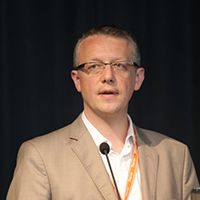Thinking Small
Pascal Cardinael and Valérie Agasse from the University of Rouen, in Mont‑Saint-Aignan, France, reveal the rationale behind miniaturization and the latest developments in miniaturized gas chromatography (GC).
millaf/stock.adobe.com

Pascal Cardinael and Valérie Agasse from the University of Rouen, in MontâSaint-Aignan, France, reveal the rationale behind miniaturization and the latest developments in miniaturized gas chromatography (GC).
Q. What benefits does miniaturization offer analytical scientists?
Pascal Cardinael: Miniaturization offers new possibilities for analytical chemists and can drastically reduce analysis time, gas consumption, and analysis costs (1). The required quantity of sample is also drastically reduced, which is crucial for high added-value samples or for samples available in very low amounts. Moreover, analyses can be performed directly on site, without wasting time or risk of contamination of the sample. The miniaturization of autonomous systems will also make it easier to implement online process measurement systems.
Q. Could you provide a general overview of miniaturization in gas chromatography (GC) and how it has evolved ?
Valérie Agasse: For miniaturized GC, the most important points to improve system portability are to reduce the size and weight of the equipment without loss of chromatographic performance. In most cases, preconcentration is necessary to improve sensitivity because of the lower injection volume. A microâpreconcentrator (2), injector (3), column (4), and a detector based on silicon technology were developed (1,5). This technology was directly transferred from the microelectronic industry. The reduction in battery size and the extension of battery life was significant. This is why it has been essential to reduce the electrical power consumption of the equipment. As the carrier gas container should be included in the system, the decrease of column size allowed the gas flow to be reduced and thus saved.
Q. What have been the main challenges involved with miniaturizing equipment for GC?
VA: The main challenges were to reduce the size of each part of the chromatograph from the injector to the detector and, of course, from the column to the core of the separation system. The choice of the stationary phases remains limited for microcolumns in comparison with conventional capillary columns (1). Our laboratory was involved in the elaboration (6) and coating of stationary phases to extend their selectivity and the possible applications (7). We have recently developed classic stationary phases based on ionic liquid (8), but also sol-gel types (6) that we adapt to miniaturized systems. Moreover, it is necessary to maintain the performance of the chromatographic system with the size constraints in terms of extracolumn volumes. Another challenge to maintain the versatility of GC was the development of equipment with the possibility of heating the injector and of programming the column temperature-as is possible with benchtop GC devices.
Q. Have there been any important developments in miniaturization in GC recently?
PC: The important recent developments concern silicon-based modules, in particular for detection, with the development of nanoelectromechanical systems (NEMS) technology detectors and the coupling with a miniaturized mass spectrometer. Through a partnership with a leading company we are aiming to develop chemical surface modification to tune the detection selectivity of resonant NEMS (9). A very promising new design of silicon-based microcolumn, including pillar array columns for GC, has recently been reported (10).
Q. Could you talk a little about the work you are doing on the miniaturization of columns for the development of a GC system for space missions?
VA: For three years we have been fortunate to work with our colleagues from LATMOS (11) on the elaboration of a miniaturized GC. We are particularly involved in the coating of stationary phases in silicon-based microcolumns. The columns are not much larger than a two euro coin. We hope to obtain very light and robust columns with very different phases to analyze all types of organic compounds including chiral molecules. The first results are very promising.
Q. Where do you see your future research taking you?
VA: Based on our experience in phase coating, we plan to work on surface treatments to improve the chemical stability and performance of the columns. Improvement of the column design will be another way to increase column efficiency. We will also work on the preconcentrator of the sample, particularly on the trap, to enhance sensitivity.
Q. Are there any misconceptions surrounding the performance of miniaturized GC systems? What advice can you offer to other scientists thinking of using miniaturized systems in their research?
PC: The most common misconceptions about miniaturized systems concern the fragility of the systems, particularly connectors and valves, but modern systems are robust and efficient. Unfortunately, the system sensitivity is often underestimated, but the coupling with the mass spectrometer (12) and NEMS detection (13) has exhibited satisfying sensitivity for major applications. The advice we would give to our colleagues is to clearly define their needs and test one microsystem.
References
- E. Lussac, R. Barattin, P. Cardinael, and V. Peulon-Agasse, Crit. Rev. Anal. Chem.46(6), 455–468 (2016).
- T.H. Chappuis, B.A. Pham Ho, M. Ceillier, F. Ricoul, M. Alessio, J.-F. Beche, C. Corne, G. Besson, J. Vial, and D. Thiébaut, Journal of breath research12(4), 046011 (2018).
- F. Haghighi. Z. Talebpour, and A. SanatiâNezhad, Lab chip15, 2559–2575 (2015).
- I. Azzouz, J. Vial, D. Thiébaut, R. Haudebourg, K. Danaie, P. Sassiat, and J. Breviere, Anal. Bioanal. Chem. 406, 981–994 (2014).
- S.C. Terry, J.H. Jerman, and J.B. Angell, IEEE Trans. Electron. Devices26, 1880–1886 (1979).
- G. Delahousse, V. Peulon-Agasse, J.-C. Debray, M. Vaccaro, G. Cravotto, I. Jabin, and P. Cardinael, J. Chromatogr. A1318, 207–216 (2013).
- Elodie Lussac, Thèse, Université Rouen Normandie, France (2016).
- A. Curat, S. Tisse, A. Andrieu, N. Bar, D. Villemin, and P. Cardinael, Chromatographia77(23–24), 1671–1681 (2014).
- https://www.apixanalytics.com/technology/19-04-17
- S. Jespers, S. Schlautmann, H. Gardeniers, W. De Malsche, F. Lynen, and G. Desmet, Anal. Chem.89, 11605–11613 (2017).
- http://www.latmos.ipsl.fr/index.php/fr/
- http://www.perkinelmer.com/fr/product/torion-t-9-portable-gc-ms-instrument-ntsst090500
- https://www.apixanalytics.com/wp-content/uploads/2017/05/Analysis-of-Natural-Gas.pdf

Pascal Cardinael graduated with a master’s degree in organic chemistry in 1994 and obtained his Ph.D. degree in analytical chemistry in 2000 from the University of Rouen (France). In 2001, he became a lecturer, in the Laboratory of Separative Methods and Sciences at the University of Rouen Normandy and a professor in analytical chemistry in 2011. He has managed the chromatography team since 2012. The laboratory focuses on the development of new stationary phases and miniaturized columns for gas chromatography. All practical and fundamental aspects of comprehensive two-dimensional gas chromatography are also studied including modulator technology, retention modelling, and coupling with high-resolution mass spectrometry.

Valérie Peulon-Agasse obtained her Ph.D. in electrochemistry from Pierre and Marie Curie University (Paris VI, France) in 1993. After a two-year thematic reconversion, she became a lecturer in 1996 at the University of Rouen. In the chromatography team of the Separative Sciences and Methods Laboratory, her research work focuses mainly on the development of stationary phases for liquid and gas chromatography and the development of multidimensional methods for gas chromatography. She is also interested in the coupling of ion chromatography with mass spectrometry for the separation and quantification of polar organic compounds.
E-mail:pascal.cardinael@univ-rouen.fr / valerie.peulon@univ-rouen.fr

Study Examines Impact of Zwitterionic Liquid Structures on Volatile Carboxylic Acid Separation in GC
March 28th 2025Iowa State University researchers evaluated imidazolium-based ZILs with sulfonate and triflimide anions to understand the influence of ZILs’ chemical structures on polar analyte separation.












